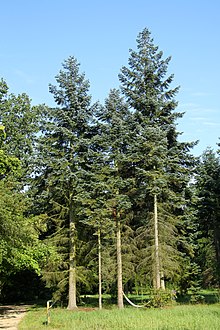Abies procera
| Abies procera | |
|---|---|

| |
| Scientific classification | |
| Kingdom: | Plantae |
| Clade: | Tracheophytes |
| Division: | Pinophyta |
| Class: | Pinopsida |
| Order: | Pinales |
| Family: | Pinaceae |
| Genus: | Abies |
| Species: | A. procera
|
| Binomial name | |
| Abies procera | |

| |
| Natural range | |
| Synonyms[2] | |
| |
Abies procera, the noble fir,[3] also called red fir[3] and Christmas tree,[3] is a western North American fir, native to the Cascade Range and Coast Range mountains of extreme northwest California and western Oregon and Washington in the United States. It is a high-altitude tree, typically occurring at 300–1,500 m (980–4,920 ft) altitude, only rarely reaching the tree line.
Description[]
A. procera is a large evergreen tree up to 70 m (130–230 ft) tall and 2 m (6.5 ft) in trunk diameter, rarely to 90 m (295 ft) tall and 2.7 m (8.9 ft) in diameter,[4] with a narrow conic crown. The bark on young trees is smooth and gray with resin blisters, becoming red-brown, rough and fissured on old trees. The leaves are needle-like, 1–3.5 cm long, glaucous blue-green above and below with strong stomal bands, and a blunt to notched tip. They are arranged spirally on the shoot, but twisted slightly S-shaped to be upcurved above the shoot. The cones are erect, 11–22 cm (4.3–8.7 in) long, with the purple scales almost completely hidden by the long exserted yellow-green bract scales; ripening brown and disintegrating to release the winged seeds in fall.
The specific epithet procera means "tall".[5]
A. procera is very closely related to red fir (A. magnifica), which replaces it farther southeast in southernmost Oregon and California, being best distinguished by the leaves having a groove along the midrib on the upper side; red fir does not show this. Red fir also tends to have the leaves less closely packed, with the shoot bark visible between the leaves, whereas the shoot is largely hidden in noble fir. Red fir cones also mostly have shorter bracts, except in A. magnifica var. shastensis; this variety is considered by some botanists to be a hybrid between noble fir and red fir.
Uses[]
Noble fir is a popular Christmas tree.
The wood is used for general structural purposes and paper manufacture.
The prostrate grey cultivar A. procera (Glauca Group) ‘Glauca Prostrata’ has gained the Royal Horticultural Society’s Award of Garden Merit. [6][7]

Cone
Cone

Foliage
References[]
- ^ Farjon, A. (2013). "Abies procera". IUCN Red List of Threatened Species. 2013: e.T42296A2970458. doi:10.2305/IUCN.UK.2013-1.RLTS.T42296A2970458.en.
- ^ "The Plant List: A Working List of all Plant Species".
- ^ Jump up to: a b c "Abies procera". Germplasm Resources Information Network (GRIN). Agricultural Research Service (ARS), United States Department of Agriculture (USDA). Retrieved 17 December 2017.
- ^ "Gymnosperm Database - Abies procera". Retrieved 2013-09-06.
- ^ Harrison, Lorraine (2012). RHS Latin for Gardeners. United Kingdom: Mitchell Beazley. ISBN 978-1845337315.
- ^ "Abies procera (Glauca Group) 'Glauca Prostrata'". RHS. Retrieved 14 August 2019.
- ^ "AGM Plants - Ornamental" (PDF). Royal Horticultural Society. July 2017. p. 1. Retrieved 14 August 2019.
Further reading[]
- Conifer Specialist Group (1998). "Abies procera". IUCN Red List of Threatened Species. 1998. Retrieved 12 May 2006.
External links[]
| Wikimedia Commons has media related to Abies procera (noble fir). |
- USDA Plants Profile for Abies procera (noble fir)
- Interactive Distribution Map of Abies procera
- Abies procera—Gymnosperm Database
- Jepson Manual Treatment: Abies procera
- photos of Abies procera trees—Arboretum de Villardebelle
- photos of foliage and cones—Arboretum de Villardebelle
- Abies procera—U.C. Photo gallery
- IUCN Red List least concern species
- Abies
- Flora of the Cascade Range
- Flora of the Klamath Mountains
- Least concern flora of the United States
- Trees of the Northwestern United States
- Trees of the United States
- Trees of the West Coast of the United States
- Trees of North America
- Trees of the Western United States



